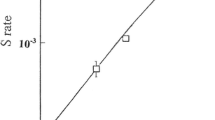Abstract
Using a tritiated amino acid suicide procedure designed specifically to select conditional protein synthesis mutants, we have isolated and characterized a large number of such mutants of Chinese hamster ovary cells. All of the mutants are genetically stable and behave as recessives in somatic cell hybrids. Most of the new mutants are phenotypically dependent on the concentration of a specific amino acid as well as on temperature. In addition to identifying many additional leucyl- and asparagyl-tRNA synthetase mutants, complementation analysis has distinguished four new genetic classes representing methionine-, glutamine-, histidine-, and arginine-dependent mutants. Biochemical characterization of representative mutants from each of these six classes has identified the primary lesions as being defective aminoacyl-tRNA synthetases. Our selection results further demonstrate the high specificity of the3H-amino acid procedure for isolating protein synthesis mutants. Reconstruction experiments performed with two representative mutants indicated a selection efficiency of approximately 10% under standard conditions.
Similar content being viewed by others
Literature cited
Basilico, C. (1977).Adv. Cancer Res. 24:222–266.
Thompson, L. H., and Baker, R. M. (1973). InMethods in Cell Biology, Vol. 6, (edited by D. M. Prescott) Academic Press, New York, pp. 209–281.
Thompson, L. H., Harkins, J. L., and Stanners, C. P. (1973).Proc. Natl. Acad. Sci. U.S.A. 70:3094–3098.
Stanners, C. P., and Thompson, L. H. (1974). InControl of Proliferation in Animal Cells, Cold Spring Harbor Conferences on Cell Proliferation, Vol. 1, (edited by B. Clarkson and R. Baserga) Cold Spring Harbor Laboratory, pp. 191–203.
Molnar, S. J., and Rauth, A. M. (1975).J. Cell Physiol. 85:173–178.
Thompson, L. H., Stanners, C. P., and Siminovitch, L. (1975).Somat. Cell Genet. 1:187–208.
McBurney, M. W., and Whitmore, G. F. (1976).Cell 2:173–182.
Taylor, R. T., and Hanna, M. L. (1977).Arch. Biochem. Biophys. 181:331–344.
Thompson, L. H., Lofgren, D. J., and Adair, G. M. (1977).Cell 11:157–168.
Stanners, C. P., Eliceiri, G. L., and Green, H. (1971).Nature (London) New Biol. 230:52–54.
Davidson, R. L., and Gerald, P. S. (1976).Somat. Cell Genet. 2:165–176.
Davidson, R. L., O'Malley, K. A., and Wheeler, T. B. (1976).Somat. Cell Genet. 2:271–280.
Kao, F. T., Chasin, L., and Puck, T. T. (1969).Proc. Natl. Acad. Sci. U.S.A. 64:1284–1291.
Roufa, D. J., and Reed, S. J. (1975).Genetics 80:549–566.
Haralson, M. A., and Roufa, D. J. (1975).J. Biol. Chem. 250:8618–8623.
Wasmuth, J. J., and Caskey, C. T. (1976).Cell 9:655–662.
Gupta, R. S., and Siminovitch, L. (1976).Cell 9:213–221.
Hankinson, O. (1976).Somat. Cell Genet. 2:497–507.
Patterson, D., Kao, F. T., and Puck, T. T. (1974).Proc. Natl. Acad. Sci. U.S.A. 71:2057–2061.
Kao, F. T., and Puck, T. T. (1975).Genetics 79:343–352.
Jones, C., and Moore, E. E. (1976).Somat. Cell Genet. 2:235–243.
Patterson, D. (1976).Somat. Cell Genet. 2:41–53.
Patterson, D. (1976).Somat. Cell Genet. 2:189–203.
Patterson, D., and Jones, C. (1976).Somat. Cell Genet. 2:429–439.
Patterson, D., Waldren, C., and Walker, C. (1976).Somat. Cell Genet. 2:113–123.
Gupta, R. S., and Siminovitch, L. (1977).Cell 10:61–66.
Jones, G. E., and Sargent, P. A. (1974).Cell 2:43–54.
Stanley, P., Caillibot, V., and Siminovitch, L. (1975).Somat. Cell Genet. 1:3–26.
Stanley, P., and Siminovitch, L. (1977).Somat. Cell Genet. 3:391–406.
Flintoff, W. F., Spindler, S. M., and Siminovitch, L. (1976).In Vitro 12:749–757.
Siminovitch, L. (1976).Cell 7:1–11.
Worten, R. G., Ho, C. C., and Duff, C. (1977).Somat. Cell Genet. 3:27–45.
Chasin, L. A. (1973).J. Cell Physiol. 82:299–308.
Hsie, A. W., Brimer, P. A., Mitchell, T. J., and Gosslee, D. G. (1975).Somat. Cell Genet. 1:247–261.
Denney, R. M., and Craig, I. W. (1976).Biochem. Genet. 14:99–117.
Shimizu, N., Kucherlapati, R. S., and Ruddle, F. H. (1976).Somat. Cell Genet. 2:345–357.
Author information
Authors and Affiliations
Rights and permissions
About this article
Cite this article
Adair, G.M., Thompson, L.H. & Lindl, P.A. Six complementation classes of conditionally lethal protein synthesis mutants of CHO cells selected by3H-amino acid. Somat Cell Mol Genet 4, 27–44 (1978). https://doi.org/10.1007/BF01546491
Received:
Revised:
Issue Date:
DOI: https://doi.org/10.1007/BF01546491




